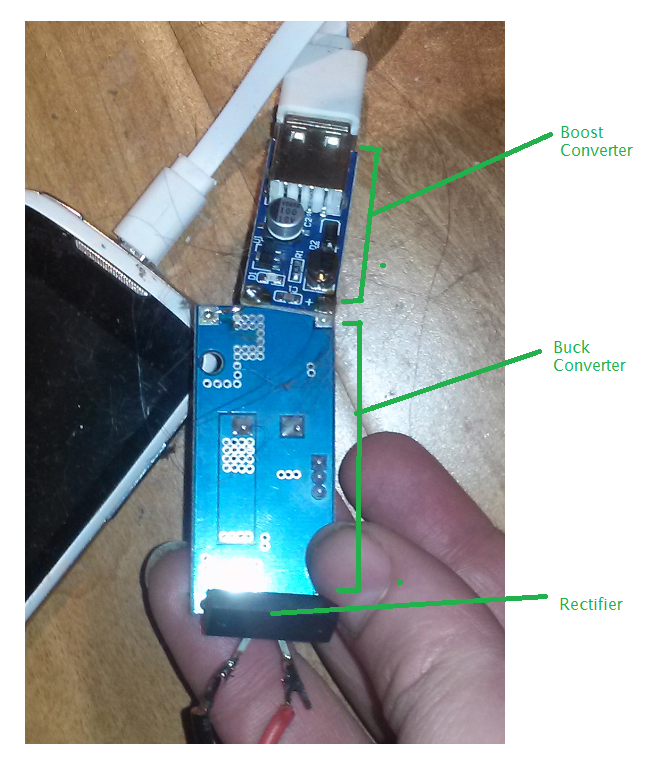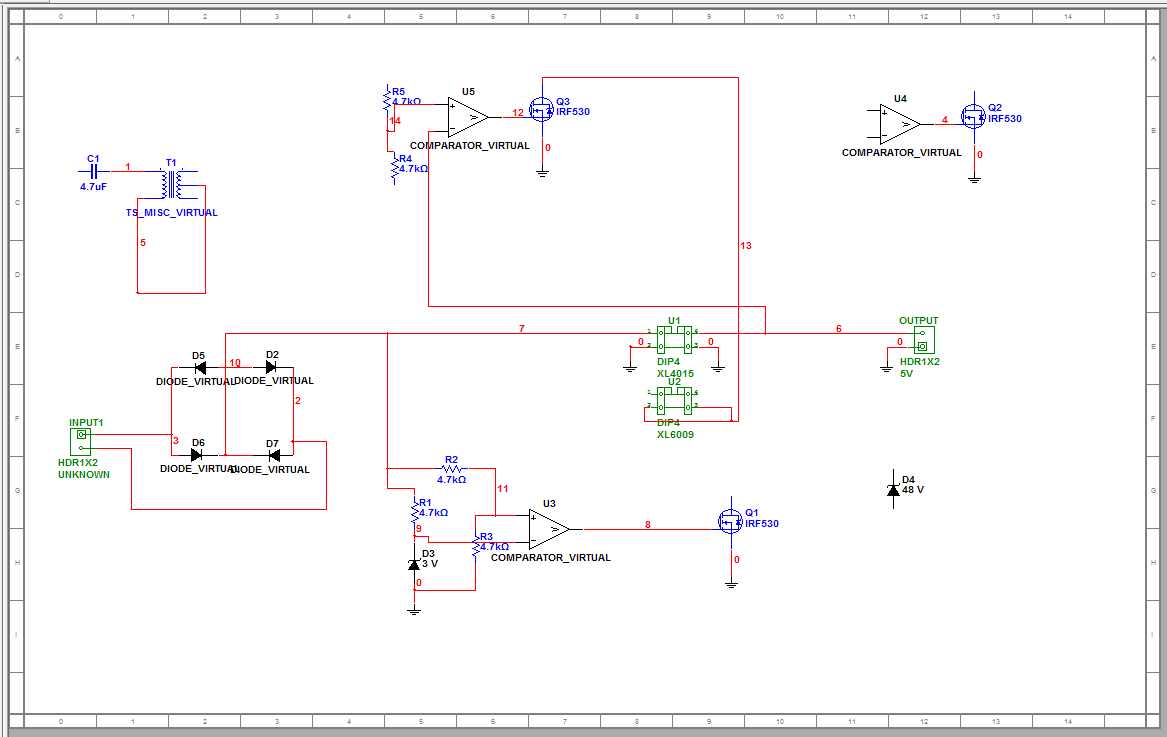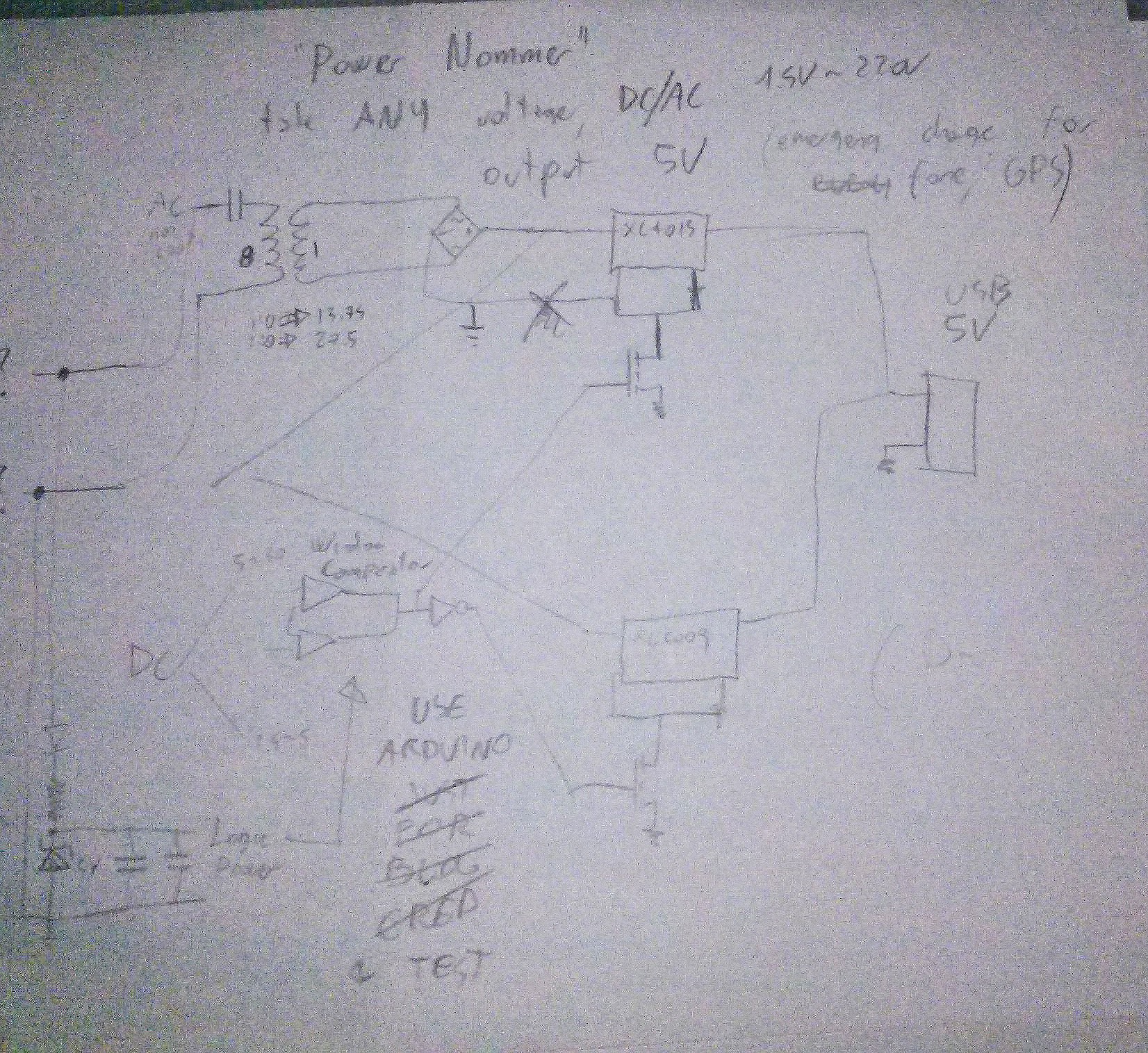-
Explanation of Improved Redesign - Video and Rationale
08/13/2018 at 09:01 • 0 commentsHere's a little movie of Matteo working on our next prototype of the Vampire Charger:
https://archive.org/details/MatteoBorri-NewVampireCharger
Direct link to video file, if needed: https://archive.org/download/MatteoBorri-NewVampireCharger/Matteo-Borri-Program-Log-New-1.mp4
Our Vampire Charger can also be thought of as a "Universal Charger."
The idea is that you have two piece of wire - in the video they are black and red, but they don't have to be marked clearly, as one of the points of this device is that you might not know which is which, so, to be clear the polarities don't matter. (At the very end of the video, after the phone turns on, Matteo switches the red and black inputs, to demonstrate this point.)
As Matteo explains in the video, the idea is that, regardless of what type of power input you have, you should be able to get enough juice to power a small USB device, such as a phone.
A hand-wired prototype for this was given last year to a friend in Puerto Rico, who was able to use it to call his wife after Hurricane Maria. The goal now is to make it into something that can be mass produced.
In our improved design, Matteo decided to not use a microcontroller. This is because even a basic microcontroller requires a PC for programming it, and he wanted this device to be buildable with as few external tools as possible.
“Perfection in design is achieved not when there is nothing more to add, but when there is nothing more to take away” - Leonardo da Vinci.
Instead, the logic that determines what regulators to bypass will be built from a network of operational amplifiers used as comparators. This is NOT a neural network, but it is similar to how a single neuron works.
As you will see now, this is sufficient to get power from DC voltages, be they 1) Car Battery 2) Boat Battery or 3) Solar Panel or 4) RC Battery even!
The solution is (See photo below.):
1) a bridge rectifier
2) A buck converter from about 30 volts to 4.
3) A little boost converter going from 4 to 5.
![]()
-
Output and Logic Details
07/16/2018 at 08:45 • 0 comments![]()
Right part: The output.
Bottom part: The logic. We will be using window comparators, for efficiency. Right now using an arduino to drive some relays to do a proof of concept.
To increase efficiency, there’s going to be one LED for the whole board ( lit = OK, not lit = not OK) that will turn itself off when the USB cable is inserted, by seeing if anything is connected to the data line. (If it doesn’t turn off because the USB device is charge only, we’ll live with it, maybe add a toggle switch).
-
Schematics for Vampire Charger Design for Solar Survival Hackathon Project
07/16/2018 at 08:38 • 0 commentsAll Designs By Matteo Borri - Robots Everywhere LLC - Spiritplumber@gmail.com.
Matteo is the lead developer on this, our first, Aaron Swartz Day Solar Survival Project.
![]()
![]()
-
Video Explaining the Vampire Charger & How it works
07/16/2018 at 08:25 • 0 commentsHere’s a short video where Matteo explains how the Vampire Charger works.: https://ia601505.us.archive.org/33/items/VampireCharger/VampireCharger.mp4
Vampire Charger – How It Works Here’s a short video where Matteo explains how the Vampire Charger works. Step 1: find a battery in some device, and you don’t know exactly: -what exactly the voltage is -what exactly the current is Step 2: Connect the contacts to your phone: – plus or minus/color doesn’t matter – AC or DC -
More about the Vampire Charger - As Discussed in Mondo 2000
07/16/2018 at 08:18 • 0 commentsMeet Matteo Borri and His Recent Inventions:
Excerpt explains a few more details about the Vampire Charger:
LR: Tell me about this stuff you invented to help Puerto Rico. It is really interesting. The solar cell phone charger and the thing you call a “Vampire Charger,” that enables you to get whatever battery power is left out of any battery without the danger of blowing up your phone if the voltage doesn’t match.
MB: Yes. I named it the “Vampire Charger.” It is an inefficient but flexible device which will take any voltage that you might find in the world – from 1.5 volts to 12 volts – to even 110! (That’s when it stops, as 220 will blow it up, but 220 is not a common voltage in the U.S., so if you’re over here, it’s not a problem. I’ll have to come up with an European adapter
LR: So this is for when something bad has happened, obviously, and you need whatever power you can get, right?
MB: Yes. The idea is that you can use it with any kind of source of power that still works. You don’t know the voltage, you don’t know the current. You don’t even know which is plus and which is minus. You don’t even know if it’s AC or DC!
It has two alligator clips.You connect them to ANY two contacts of the part in question, in any way. (To be clear: the color it doesn’t even matter, in this case.) And it gives you USB power, safely!
LR: I’ve never seen anything else like these Vampire Chargers – in terms of options to keep your phone alive after a disaster. I mean there are batteries that you can keep charged up; and this. Right?
LR: Why doesn’t the plus or minus or AC/DC matter? What is going on technically?
MB: It has a Schottky rectifier. Then it has a step up. Then it has a step down. So, it’s a bit inefficient, but flexible.
LR: Inefficient how?
MB: Let’s say there was 10 watts of power in a battery. Only 6 watts of that might make it to your phone. Beats the 0 watts you would get without an adapter, or with the wrong adapter.
Vampire Charger
The Vampire Charger takes in any AC or DC voltage that may be findable in an emergency situation and delivers it safely to your USB device.
 Aaron Swartz Day
Aaron Swartz Day



